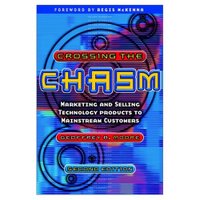
The lucidity of Moore’s writing makes his arguments both compelling and persuasive. Given the reported influence that his text has had on both the technology and other market segments it is difficult to challenge the merit and value in the contribution that he makes.
However, before jumping into (or dare we say over) the chasm, it is perhaps worthwhile reflecting on some suggested limitations to Crossing the Chasm.
(1) What about the product?
How to assess the marketability of a product, the thought process to be followed and hurdles to be overcome is almost entirely neglected by Moore. Clearly the intrinsic merit of a product is important (albeit not determinative - consider Betamax and VHS), as is assessing the potential market. Moore may rely upon the innovator segment in the life cycle to filter wheat from chaff, but how realiable is this? Can judgment not be brought to bare at drawing board stage?
(2) The bell curve segments: a nebulous populous
Perhaps of more concern is the populous of the what Moore potrays to be rigid adoption cycle segments. They are defined by volume. This, it is submitted has two consequences:
(i) It can never be wrong
If the first x% are early adopters, the next Y% early majority etc., they will be so by definition regardless of psycho-social profile.
(ii) What if defined by characteristic response?
No allowance is made by Moore to the product or exact market segment. Could it not be that some segments are occupied by more visionaries than pragmatists etc.?
(iii) The occupants of the segment cannot be definitively identified until they have demonstrated their response to the disruptive innovation
After all it is this response (notwithstanding the above) which defines the segment that is to be occupied by them. So, whilst Moore suggests we should target segments, and thus focus our attack informed by the characteristics of the relevant buying group, how this is actually to be done before such a reaction is displayed is perhaps under developed.
(3) The story of a maturing product
Whilst Moore can marshal many examples that apparently support the adoption cycle – it is by no means clear that this was the driver for it. Could the transition simply be explained by broadening the potential market. Product X appeals to Y amount of technology focussed people/companies. This having been successfully the product is developed and matured to increase its appeal to more people and so on. If this analysed in Moorian terms as crossing the chasm, and if this is such a precarious ordeal, wouldn’t all companies relate to this journey, is this in fact the case? Or did the product mature and the market broaden as a consequence.
(4) Final analysis – the need for judgment and intuition
Few if anybody could argue that the challenges to bringing a new technology to market are near overwhelming. To successfully navigate the journey must require intuition and good judgment. Moore himself concedes this when identifying the target at the other side of his chasm. Therefore, the irresistibility of his writing, whilst identifying the key decisions, may ‘gloss’ over the judgement required to achieve success at such moments.
Perhaps therefore to those embarking on such a journey, the Moore route map will educate the thought process and become an invaluable aid in navigation; this of course cannot be a substitute for an intuitive sense of direction.
Darren Maw
Naked Chasm Jumpers
However, before jumping into (or dare we say over) the chasm, it is perhaps worthwhile reflecting on some suggested limitations to Crossing the Chasm.
(1) What about the product?
How to assess the marketability of a product, the thought process to be followed and hurdles to be overcome is almost entirely neglected by Moore. Clearly the intrinsic merit of a product is important (albeit not determinative - consider Betamax and VHS), as is assessing the potential market. Moore may rely upon the innovator segment in the life cycle to filter wheat from chaff, but how realiable is this? Can judgment not be brought to bare at drawing board stage?
(2) The bell curve segments: a nebulous populous
Perhaps of more concern is the populous of the what Moore potrays to be rigid adoption cycle segments. They are defined by volume. This, it is submitted has two consequences:
(i) It can never be wrong
If the first x% are early adopters, the next Y% early majority etc., they will be so by definition regardless of psycho-social profile.
(ii) What if defined by characteristic response?
No allowance is made by Moore to the product or exact market segment. Could it not be that some segments are occupied by more visionaries than pragmatists etc.?
(iii) The occupants of the segment cannot be definitively identified until they have demonstrated their response to the disruptive innovation
After all it is this response (notwithstanding the above) which defines the segment that is to be occupied by them. So, whilst Moore suggests we should target segments, and thus focus our attack informed by the characteristics of the relevant buying group, how this is actually to be done before such a reaction is displayed is perhaps under developed.
(3) The story of a maturing product
Whilst Moore can marshal many examples that apparently support the adoption cycle – it is by no means clear that this was the driver for it. Could the transition simply be explained by broadening the potential market. Product X appeals to Y amount of technology focussed people/companies. This having been successfully the product is developed and matured to increase its appeal to more people and so on. If this analysed in Moorian terms as crossing the chasm, and if this is such a precarious ordeal, wouldn’t all companies relate to this journey, is this in fact the case? Or did the product mature and the market broaden as a consequence.
(4) Final analysis – the need for judgment and intuition
Few if anybody could argue that the challenges to bringing a new technology to market are near overwhelming. To successfully navigate the journey must require intuition and good judgment. Moore himself concedes this when identifying the target at the other side of his chasm. Therefore, the irresistibility of his writing, whilst identifying the key decisions, may ‘gloss’ over the judgement required to achieve success at such moments.
Perhaps therefore to those embarking on such a journey, the Moore route map will educate the thought process and become an invaluable aid in navigation; this of course cannot be a substitute for an intuitive sense of direction.
Darren Maw
Naked Chasm Jumpers










